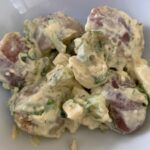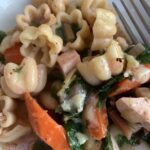Have you ever savored dill pickles so incredible that you’d bet they’re the best in the world? Well, my husband (my trusty taste-tester) and countless others absolutely adore the dill pickles I whip up. Today, I’m here to unveil the art of crafting delicious homemade dill pickles, these mouthwatering, crisp, and irresistibly tangy dill pickles right in the heart of your own kitchen. In this post, you’ll find not only the recipe but also the secrets of home canning. If you’re a seasoned canner, you probably have the gear already, but if you’re new to this, fear not! It’s not as daunting as it may seem. I promise, it’s a straightforward process—just follow the measurements, use quality ingredients, and stick to the recommended processing times.
Here’s a few things to think about:
- Make sure you have all the equipment-canner, mason jars with lids and bands
- Set aside enough time to prepare and process. Depending on how many jars of pickles you process, set aside at least 5-6 hours of time. You can’t rush this process. Plan to can immediately after getting your produce for the best results.
- Consider canning pint jars of pickles for Christmas gifts
- It’s important to choose just-picked, farmer fresh cucumbers and ingredients. Your local farmers market is a great source for the freshest quality ingredients
Equipment you will need:
- A Boiling-Water Canner (with a rack and lid)
- A jar lifter, jar funnel and lid wand (to pick up the hot lids from boiling water)
- Mason jars with proper lids and bands. Wide mouth mason jars are best for dill pickles
Use quality ingredients:
- Purchase 3-4-inch freshly picked cucumbers from the farmers market or grocery store. Cucumbers must be very fresh. No signs of softness or wilting
- Purchase whole fresh dill with stems, leaves, flowers and seeds, but if you can’t find fresh, purchase dried whole dill with stems, flowers and seeds
- Use Distilled White Vinegar with 5% acidity
- Use fresh garlic and pickling onions
- Use Pickle Crisp Granules. This ingredient will ensure your pickles will be crisp
- Use Diamond Crystal Kosher Salt or “pickling salt”. Regular Morton Table Salt contains a Iodine and anticaking agent that will create a cloudy white sediment on the bottom of your jars
- Use soft water for your brine, filtered water will work well too




How to videos to view:
- Home canning 101. A good video to review
- Water Bath Canning method

Dill-icious Delights! Homemade Dill Pickles
Equipment
- Canning Pot with rack and full set of tools This kit has all the tools you'll need plus your canner
Ingredients
- 150 fresh cucumbers 3-4 inches in length, stem end and flower end trimmed. **Keep the cucumbers in the refrigerator until ready to pack into jars
- 3 quarts water Use soft water, filtered water, or Distilled
- 1 quart White Distilled Vinegar
- 1 cup Diamond Crystal Kosher Salt
- 26 Garlic cloves, peeled divided
- 13 Pickling Onions skins removed, root trimmed, divided
- 2 cups Black Peppercorns divided
- Fresh or dry dill enough for heads and stems for all jars
- 1 jar Ball Pickle Crisp Granules
- 13 Quart wide-mouth canning jars with lids and rings
Instructions
Prepare canning jars and cucumbers
- A dishwasher may be used for washing your jars, alternately you can wash new and previously used jars in hot, soapy water.
- Make sure you have canning lids and rings for all your jars before you begin the canning process.
- We are RAW PACKING our cucumbers which means we are placing the cucumbers in the jars raw and our brine will be added before processing in the water bath.
- Under cold running water, scrub your cucumbers well with a vegetable brush, making sure you get all dirt! I separate my cucumbers by size to make it easier to pack the jars. Trim the flower end as well as the stem end off the cucumbers.

- In a large 5-6 quart pot, bring to a simmer the vinegar, water and salt.
- In a small sauce pan filled with water, place your canning lids in, bringing the water to a boil then reduce to a simmer
- Fill your canner half full with water and bring to a simmer (180℉) and position the canner rack over the simmering water.
Packing the jars with cucumbers
- For each jar add: 1-2 garlic cloves, 1 pickling onion, 1 teaspoon black peppercorns, ¼ teaspoon Ball Pickle Crisp Granules, and 1 stem of fresh dill.

- Pack your jar tightly with as many whole cucumbers as possible, leaving ½-inch head space for expansion

- Once you have 7 jars filled (that's the amount the canner can process at a time), Pour enough hot brine into the jars to ½-inch from the top of the jar.
- Using a clean, damp cloth, wipe the rim of the jar clean. Remove a lid from the simmering water and place on the jar. *Never reuse canning lids! Place a band over the lid and screw it onto the jar just until a point of resistance is met-fingertip tight. Do not screw it down as tight as you can make it.
- Using a jar lifter (because now the jar is hot from the brine), place the jar onto the canner rack that is in the canner. When you have all the jars in the canner rack, carefully lower the rack into the simmering water. The water level must cover the jars completely by 1-2-inches. Add boiling water if needed.

Water Bath Processing
- Put the canner lid on and adjust the heat to medium-high, bringing the water to a rolling boil. Once it has reached the rolling boil, set your timer for *15 minutes (see notes below).
- After the processing time is complete, turn off the heat and remove the canner lid. Let the canner cool 5 minutes before removing jars.
- To remove the jars, use the jar lifter (they will be super hot!) and carefully set them upright on a dry towel or cutting board to cool. Leave 2-inches of space between jars so they cool at an even rate. Do not tighten the bands if they loosened during processing.

Cooling and testing the seals
- Allow the jars to cool at room temperature 12 to 24 hours. Do not move the jars, invert the jars, or tighten the lids during the cooling period. It can cause the seal to fail.
- After the jars have cooled completely, test the lids to determine if the vacuum seal has formed. The best method for testing a seal is to press the center of the lid to determine if it is concave; then remove the band and gently try to lift the lid off with your fingertips. If the center does not flex up ad down and you cannot lift the lid off, the lid has a good vacuum seal. Listening for a "ping" when the lid seal, tapping the lid with a spoon or visually examining the lid is not always an accurate test.
- Label and date each jar.
Storage
- Foods canned following tested recipes, correct processing methods and processing time can be safely stored for one year. The ideal temperature range for storing home canned foods is between 50℉ and 70℉, in a cool, dry, dark room is ideal. Light hastens oxidation and destroys certain vitamins and also cause certain foods to fade in color. Store your canned goods in a place that does not receive direct sunlight.
- Leave them to cure and develop flavor for 4 to 6 weeks.












